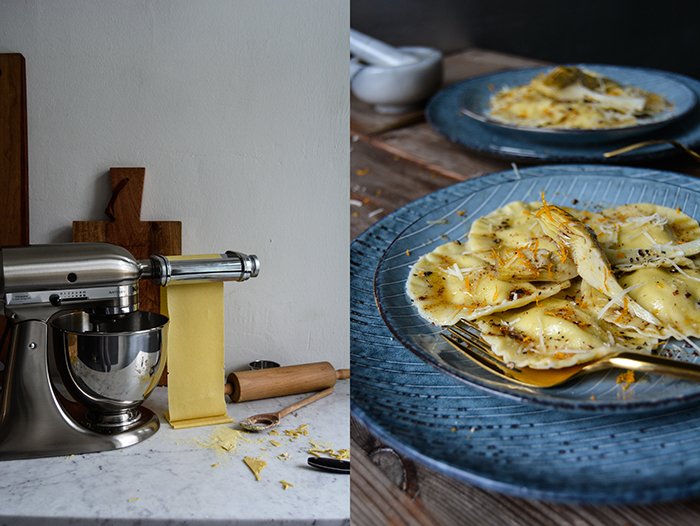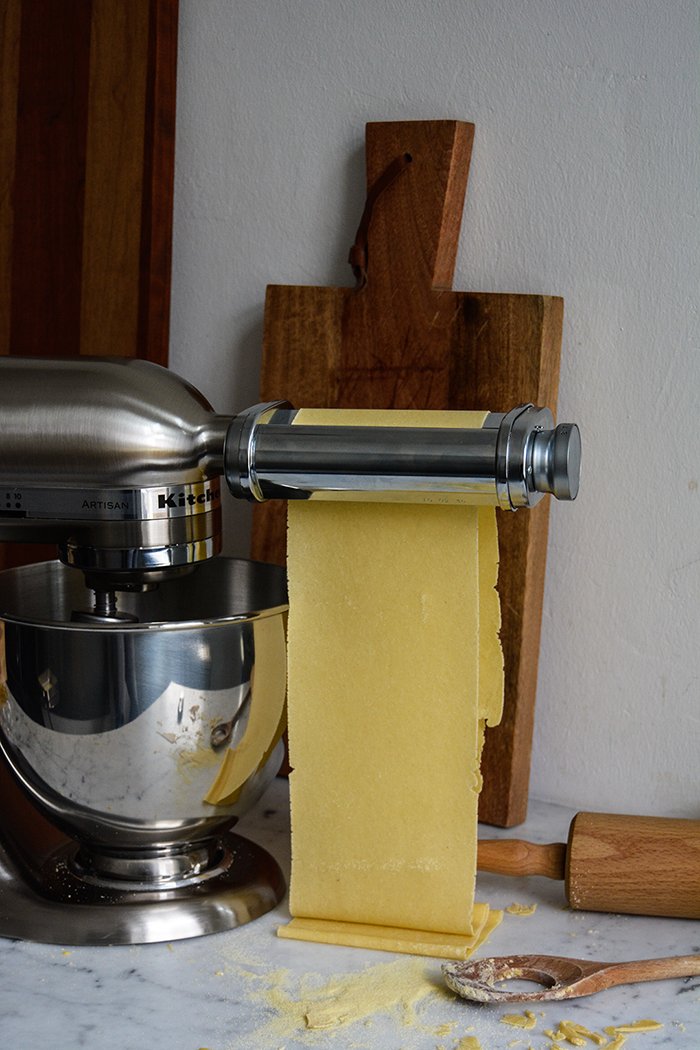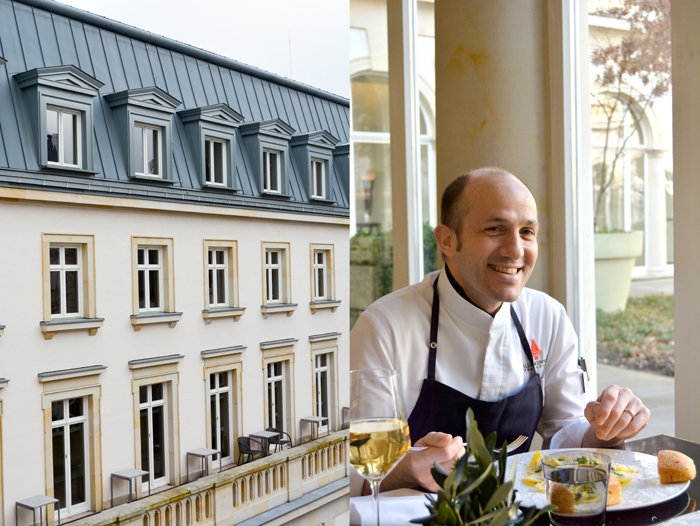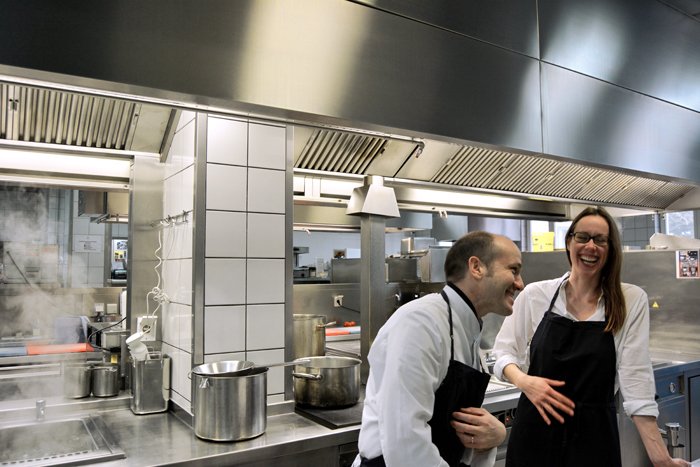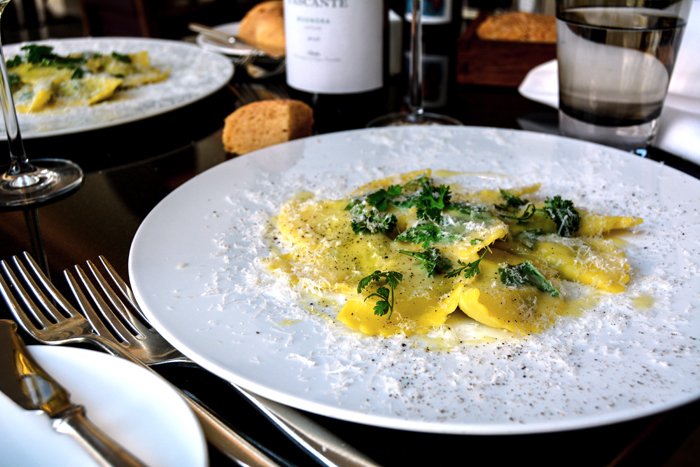Artichoke, Ricotta and Orange Ravioli
If you decide to make your own homemade pasta, be prepared that you'll never be able to eat store bought pasta again (you'll feel less satisfied with it at the very least) - and that you won't feel your arms and abs for a couple days. To knead the dough by hand is necessary and labor-intensive. I had moments when I felt slight doubts about whether the crumbly mixture in front of me would ever turn into a smooth ball, but it worked. I needed all my patience and muscle power to get there, but the result tasted so good that I'd do it all over again (after my muscles got some rest).
My pasta project started last Friday and ended on Saturday afternoon. I first tried a recipe by Sicilian chef Dario Cammarata who only uses plain flour, durum wheat semolina, salt, egg yolks, and olive oil. The result tasted amazing, but getting there was so much harder than what I remembered from when I visited the chef in his kitchen in Frankfurt earlier this year. What seemed so easy in Darios's hands, didn't want to work as smoothly in my own.
Dario taught me that ravioli are best when they are made with egg yolks and not whole eggs. I have no doubt that this is true, the texture is light and perfectly al dente. But to knead my own dough made of 10 egg yolks, flour, and semolina almost made me cry. The mixture was so hard and fragile, I needed an alternative that was less stressful. I still used my egg yolk dough to make a few ravioli, which were perfect, and I made tagliatelle. And these were the best tagliatelle of my life - taste, texture, and thickness were spot on!
Early the next morning I went back to my kitchen. More eggs in the bowl (this time including the egg whites), with a fresh and open mind and a quenchless appetite for fresh pasta, I felt optimistic. Kneading the dough still required some serious muscle power (maybe it's just me, my arms are not the strongest), but it was manageable. And this time I totally enjoyed pulling the thin layers of fresh pasta through my KitchenAid pasta attachment. I needed about two test sheets, but then I was in business. They were so thin that I could see my hand through them.
For my first homemade ravioli, I chose a filling that still allowed me to enjoy the fine taste of the egg pasta. After all this work it didn't feel right to knock it out. The combination of preserved artichokes and fresh ricotta refined with a little orange zest was just right, present, but not overpowering. I served it with melted butter and golden artichoke hearts, briefly seared in the sizzling fat. A little crushed pepper and some more orange zest, and my work was done.
My KitchenAid has three pasta attachments and I'm particularly fond of the tagliatelle cutter. Once I was done with the ravioli, all the shorter pieces and leftover dough went through this attachment and they were perfectly cut into the thinest, tastiest pasta. Cook it al dente and add a knob of butter, freshly grated aromatic hard cheese, and black pepper, and you'll have the best meal ever. Buon appetito!
Artichoke, Ricotta and Orange Ravioli
Homemade ravioli are time and labour-intensive. They are a great starter or main dish for a dinner party, but I recommend preparing them a day in advance to keep it stress free. Freeze them (uncooked) and cook them in boiling salted water just before serving for 4 minutes. I recommend using a pasta machine for this recipe.
Makes 20-24 ravioli / serves 2-4
For the pasta dough
plain flour 150g / 1 cup plus 2 tablespoons
durum wheat semolina 150g / 5 1/4 ounces
fine sea salt 1/4 teaspoon
large organic eggs 3 plus 1 egg yolk
olive oil 1 tablespoon plus 1 teaspoon
water, cold, 1 tablespoon
For the filling
preserved artichoke hearts, drained and squeezed, 160g / 6 ounces
fresh ricotta 125 g/ 4 1/2 ounces
olive oil 1 tablespoon
freshly grated Parmesan 25g / 1 ounce
a pinch of freshly grated orange zest
fine sea salt
ground pepper
For serving
butter 4 tablespoons
preserved artichoke hearts, drained and cut into 6 pieces each, 2
Parmesan
black peppercorns, crushed
a little orange zest
For the pasta dough, in the bowl of a stand mixer fitted with the dough attachment, combine the flour, semolina, and salt. Add the eggs, egg yolk, and olive oil and knead for about 5 minutes (I set it on '4' on my KitchenAid). If it's too dry, add 1 tablespoon of water, but not more. If it's too sticky, add a little semolina and flour. On the counter top or on a stable table, using your hands, continue kneading the dough for about 15 minutes until smooth. It will still be firm. I find it easiest to leave it in the shape of a thick disc for the first 5-7 minutes, punching and kneading it, and scraping the crumbs together. Then I knead it and roll it into a ball (see pictures below). Form a ball, wrap it in cling film, and let it rest in the fridge for 1 hour.
For the filling, purée the artichoke hearts, add to a bowl along with the ricotta, olive oil, Parmesan, orange zest, salt, and pepper. Whisk until smooth and adjust seasoning.
Divide the dough into 4-8 portions (depending on the width and power of your pasta machine). Roll out 1 portion with a rolling pin until it's thin enough to fit into your pasta machine. I started using position '1' on my pasta attachment, using the speed setting '2'. Pull the dough through the pasta machine twice, fold it in the middle, flatten it a little with the rolling pin if necessary, turn it 90°, and pull it through the pasta machine. Continue 2-3 times. Change to a thinner setting (I used '3') and pull the dough through the machine about 3 times, without folding it. Using a knife, straighten the sides of your pasta sheet and cut off excess dough. Continue using the thinner settings of your pasta machine until you can see your hand through the dough (I used '5' and then '6' at the end). If the dough is too sticky, use semolina, but no flour.
Sprinkle the rolled out pasta layer with semolina, fold it gently, and cover with cling film. Continue rolling the remaining dough.
Sprinkle a large baking sheet with semolina. Bring a large pot of generously salted water to the boil.
Lay out a layer of pasta and mark it with circles, using a 7cm / 3" round cutter (or whatever size and shape you prefer). Add a teaspoon of the filling in the middle of each marked circle. Dip your finger in water and wet the rim of the circles. From a second sheet of pasta, cut out circles of the same size, lay on top of the filling, and using your finger, push around the rim (see picture above). Using the cookie cutter, cut out the ravioli and press a little fork all around to seal the rim (see picture below). Transfer the ravioli to the prepared baking sheet.
In batches, cook the ravioli in the simmering water for about 2-3 minutes or until al dente.
To serve the ravioli, in a saucepan, heat the butter over high heat until golden brown, add the artichoke hearts, turn gently, and sauté for 1 minute.
Serve the ravioli sprinkled with the butter, Parmesan, orange zest (optional), and crushed pepper and lay the sautéed artichokes on top.
meet in your kitchen | Dario Cammarata's Herb Ravioli, Palermo & Villa Kennedy
Once in a while one has to enjoy the pleasures of life a bit more excessively, plenty is the right word. I convinced my boyfriend that we deserved a little break from our daily duties, to learn how to make ravioli from a true Palermo man. Luckily, my Sicilian chef, the charming Dario Cammarata, works in the kitchen of Frankurt's most beautiful hotel, the splendid Villa Kennedy, so it wasn't much work to get a 'yes' from my man.
We jumped on a train, crossed the country, and found ourselves in front of the heavy iron gates of an elegant villa. Built in 1901 for a banker family, the house looks impressive but not intimidating. Beige sandstone, zinc gables, turrets, and ornate balustrades made me feel like a princess, at least for 24 hours. I was prepared for excellent service and outstanding food - which we definitely experienced at dinner, breakfast, and lunch - but I didn't expect to feel so welcomed and nicely spoilt, so I asked myself: "Why should I ever leave again?" Be it the three porters Luciano, Mahmood, and Girgis, or the second man from Palermo in the house and maître d'hôtel, Vito Vitale, the way they treated us goes beyond politeness, their friendliness comes straight from the heart. But there were two people who I could have taken straight home with me to Berlin, Yasmin Michel and my favourite Sicilian chef Dario, our two partners in crime for 24 hours to spoil us with amazing wine, the finest champagne, and delicious treats from the kitchen of the Gusto restaurant.
Before we sat down to our Sicilian feast on the evening of our arrival, I had a chat with Dario who left his home island at the age of 18. He wanted to become a chef since first setting foot in a restaurant kitchen in Palermo as a young man of 14. As soon as he finished his training he headed to northern Europe to follow his second passion: traveling. He worked in many great restaurants, amongst them Michelin-starred restaurants in Saint-Tropez, Italy, and Switzerland, and went through the suffering that every ambitious and successful young chef has to go through. Long hours of hard work and not much sleep are the price you have to pay if you work in the world's best culinary hotspots. Dario loved it and only the love to his wife made him settle down. It's already been 10 years since he joined the Villa Kennedy as the Executive Chef and - being a father of three children now - Dario wouldn't change anything. He enjoys cooking at home with his kids, introducing them to the vast knowledge and traditions he learned from his Sicilian Mamma Saveria. Dario praises her cooking and, although he admits that no Sicilian man would ever say his mother isn't talented in the kitchen, Saveria must be a true gem. She's critical - of course - she has very high standards when it comes to food, so much so that she sometimes cooked three different dishes for lunch to please the individual taste of her three sons when they were young. This woman loves her food - and her family. After one of Dario's visits to his Mamma's kitchen earlier this year, he decided to take a few of her recipes up north to introduce the guests of the hotel to the Mamma's Menu:
Anelletti alla Trapanese con Tartara di Gamberoni alla Menta (Anelletti Trapanese pasta with king prawn tatar and mint)
Involtini di Pesce Spada con Insalatina di Finocchi ed Agrumi, Calamaretti (swordfish involtini with fennel and citrus fruit salad and calamaretti)
Trio di Cannoli con Gelato al Pistacchio (cannoli trilogy with pistacchio ice cream)
We enjoyed it in silence, only accompanied by a few Ohh's and Ahh's and a bottle of amazing Sicilian white wine - divine. Grilled polpo with potatoes was next, beautifully hearty Ravioli con Sanguinaccio, Pera E Sedano Rapa (black pudding ravioli with pear and celeriac), and a heavenly buffalo ricotta cheesecake with blueberry sorbet. This dinner left me happy, stuffed, and ready for bed.
The next day started with an early morning swim in the peaceful spa, followed by lots of laughter and excitement in the kitchen - and even more fantastic food. I should have skipped breakfast as I had a cooking date with Dario ahead but it looked too tempting so I gave in. Sometimes in life you just have to go with the flow and enjoy what it offers - in this case, plenty of good food. We put on our aprons and I felt ready to learn how a Sicilian man who lives in the cold north makes ravioli. He uses what Mamma taught him to prepare the perfect pasta dough and combines it with one of the most popular classics of his new home: the Frankfurt green sauce, enriched with ricotta to fill the ravioli. The sauce is a traditional recipe from the Frankfurt region, made with seven fresh herbs: parsley, chives, chervil, borage, sorrel, garden cress, and salad burnet. In Germany, you can by them ready packed for this sauce but Dario recommends buying them singly, otherwise you'll end up with lots of (cheaper) parsley and little of the more expensive herbs. If you can't find all of them at your market, just skip one or replace it - I know that true Frankfurt green sauce defenders wouldn't agree with me but we're talking about cooking and not science. Dario says that a bit of fresh mint or lemon would also fit his ravioli filling to freshen it up. Just be experimental. And if you'd like to see a little video of Dario making ravioli, check out my Snapchat (@eatinmykitchen).
Although we laughed the whole time, we managed to successfully make ravioli and they were the best spring ravioli I ever had in my life - fresh and green, not too heavy and packed with flavour. From now on, Dario is my favourite Sicilian chef. His approach to food, the honesty and restraint in his recipes, the Sicilian way of playing with contrasting aromas, and his focus on only the best quality ingredients often imported from Sicily by himself, impressed me and made my taste buds jump.
Thank you for everything, you wonderful people at Villa Kennedy!
I can also recommend joining the Friday Chef's Table if you happen to be in Frankfurt - it's a gathering around the table in the Gusto kitchen to see and smell how you're food is prepared.
Dario Cammarata's Herb Ricotta Ravioli
Serves 6
For the pasta dough
plain flour 250g / 2 cups
durum wheat semolina 250g / 9 ounces
fine sea salt 1 teaspoon
egg yolks 15
olive oil 3 tablespoons
For the filling
fresh ricotta 250g / 9 ounces
a mix of 7 herbs: borage, chervil, garden cress, parsley, pimpinella (salad burnet), sorrel, chives, the leaves finely chopped, 1 large bunch
fresh basil leaves, finely chopped, 1 small handful
fresh mint leaves, finely chopped, 6, or a little lemon zest (optional)
Parmesan, freshly grated, 150g / 5 ounces
fine sea salt
ground pepper
For the topping
butter, melted, about 6 tablespoons
Parmesan, freshly grated, about 6 tablespoons
fresh herbs, leaves only, 1 handful
ground pepper
For the pasta dough, in a large bowl, combine the flour, semolina, and salt. Add the egg yolks and olive oil and mix for a few minutes until smooth and well combined, using your hands or the dough hooks of an electric mixer. Form a ball, wrap in cling film, and let it sit for 20 minutes.
For the filling, in a large bowl, add the ricotta and whisk in the chopped herbs and Parmesan until well combined. Season with salt and pepper to taste.
Using a pasta machine or rolling pin, roll the dough very thinly, you should be able to see your hand through the dough.
In a large pot, bring salted water to the boil.
To give the ravioli half moon-shapes, cut out circles using a 9cm / 3 1/2" cookie cutter. Put a spoonful of the filling in the middle of each circle and, using your finger, spread a little water all along the pasta rim. Fold half of the ravioli over to end up with a half moon-shape, push the rim well with your fingers to seal the filling inside.
Turn the water down to simmering and cook the ravioli for about 2-3 minutes or until al dente.Divide the ravioli between plates, drizzle with melted butter, and sprinkle with Parmesan, fresh herbs, and season with a little ground pepper.
Buon Appetito!
When you left Palermo at the age of 18, did you have a plan in mind, or a dream that you wanted to achieve? Or did you just jump into this big adventure?
I always wanted to become a chef, I already knew that at quite a young age. I didn't have a plan in mind but I had a goal. At the same time, I wanted to travel the world and I was after a job that would allow me to combine my two passions. It was a mix of planning and adventure, so when I finished school in Sicily at the age of 19, I packed my bags and left - off to Sirmione at Lake Garda. This was the beginning of my great dream and from then on it continued.
What did it mean to you to work in Michelin-starred restaurants in Italy, France, and Switzerland as a young man? What fascinated you about the work in these kitchens?
It meant a lot to me and it still does. I was particularly fascinated by these countries. I admire Italy and France's long kitchen traditions. So many amazing dishes and excellent chefs originated from these two cuisines. Switzerland, to me, stands for decades of tradition in the hotel business. They have outstanding houses with great restaurants.The amount of people working in Michelin-starred restaurants impressed me tremendously. At Badrutt's Palace, in Saint-Tropez, our kitchen team was made up of 61 people - it's unbelievable. I'm very proud of having worked there, and I wouldn't want to miss the experience, but it was never a must for me to work at these restaurants. It was far more important for me to learn about different countries and cultures and their traditions. Cooking connects us, to me it's easiest to understand various nations and habits through their cuisines.
What was the most important lesson you learned as a young chef?
Little things often have the greatest effects. Both positive and negative. This is what my boss in Saint-Tropez used to tell me and it became the cooking mantra of my life. It's the guideline I pass on to my team now.
You grew up with the Sicilian cuisine cooked by your Mamma Saveria, how did your home island's culinary traditions influence your style of cooking and your approach to food?
A lot! I wouldn't be the Dario I am today without the influences of my Sicilian home - and especially my Mamma. In particular when it comes to my cooking. At the age of 2 or 3, I already joined my Mamma in the kitchen. I didn't necessarily help her, but I tasted everything, and that's what I remember clearly. Already then, I was fascinated by the preparation of food and watching and learning at such a young age definitely affected my style of cooking, my outlook on produce, and the way I work with food.
If you had to point out the main differences between cooking and living in Italy and Germany, what would they be? What do you like about German cooking?
Italians live and eat differently to Germans. Italians "take their time for life", and food is a great part of it. To enjoy life is so important in the life of an Italian. Eating together is a feast, a celebration, no matter what we eat, what day of the week it is, or if we had a good or bad day. We savour the time together to the last second.Germans are more influenced by the experiences they had during the day - Italians aren't really like this. Eating together, being together, that's most important. What I like about German cooking, is that people start to go back to their roots. Regional produce, traditional recipes, and cultural gems are being re-discovered, that's great. This has always been important in Italian and French cuisine, so it's fantastic that more and more German chefs and cooks follow this trend.
Where do you find inspiration for new recipes?
Preferably directly at the farmers' market. Seasonal fresh produce inspires me, many of my ideas come up right there. I like the combination of tradition and new takes on recipes, this adds new qualities to a dish. And I love running, it allows my mind and creativity to be free, it relaxes me but at the same time it sparks lots of new ideas that I want to try in the kitchen immediately.
What do you miss the most about Sicily?
The sea! And the smell of the Zagara (orange blossom) flower. I really miss it. When I see the sea and I have this smell in my nose, I know that I'm home. And, of course, I miss my Mamma's cooking! That's why I imported her to Germany (see the Villa Kennedy Mamma's Menu in my introduction).
Who is your biggest inspiration in the kitchen?
My Mamma! Like I said, she inspired me at a very young age and from her, I learned about all the traditional Sicilian recipes, which I'm very grateful for. Another inspiration for my career was the chef Ludovic Laurenty, my boss at Château de Pray (in the Loire Valley). He taught me the importance of staying calm - he used to be the calmest person ever. I learned a lot from him and I still think a lot of him, like all the other chefs I've worked with - you take a piece of each of them with you.
What was the first dish you cooked on your own, what is your first cooking memory?
Involtini di melanzane (eggplant rolls), I was 15 and I cooked them for a good friend of mine. Typically Sicilian, it's an easy dish and still one of my favourites. You should try it!
What are your favourite places to buy and enjoy food in Palermo and in Frankfurt?
In Sicily, I like to go to Bisso Bistrot in Palermo. It's a cosy, friendly, and original Sicilian restaurant. In Frankfurt, I regularly go to the Kleinmarkthalle (a farmers' market hall), here you can buy and eat food at the same time. First, I choose the fresh produce I need and then I enjoy a glass of wine and some antipasti. In Wiesbaden, where I live, I like to go to Gusto E. A former colleague of mine runs this pretty little restaurant, I always get a warm welcome and scrumptious food.
If you could choose one person to cook a meal for you, who and what would it be?
The Sicilian director Giuseppe Tornatore. His movies open my heart - not just because he's Sicilian (laughing). He seems to be a great guy and I love his way of making movies, he carries a lot of Sicily out into the world, that always impressed me. I would make cannoli with him. It's typical for our home island and I'd love to go to the farmer together with Giuseppe to buy ricotta, or we'd make our own. Maybe he would even put this scene into one of his next movies.
You're going to have ten friends over for a spontaneous dinner, what will be on the table?
Parmigiana - I love this vegetable-Parmesan-casserole dish. It's the taste of Sicily. Pasta is next, I would see what fits to the season. If my friends came over in the spring, I'd make orecchiette with fava beans, fresh tomatoes, prawns, pine seeds, and basil. Fish as main, two oven-roasted sea bass with lots of herbs and lemon, and tiramisu or a tart with fresh raspberries as dessert.
What was your childhood's culinary favourite and what is it now?
My Mamma'sParmigiana. It's always been my favourite and it still is. Whenever I go to Siciliy, I can be sure to find it on my Mamma's table - she knows me too well.
Do you prefer to cook on your own or together with others?
I never cook alone. Cooking connects us and it's far more fun to do it together with others. Even if someone just watches. I love to cook together with my wife and my three kids. Cooking on my own is boring.
Which meals do you prefer, improvised or planned?
I prefer to improvise. It bores me to plan every single detail. When you improvise, you can change and adjust and create something new. That keeps it interesting.
Which meal would you never cook again?
That's not easy... 4 years ago, we had the final for a national cooking competition at the Villa Kennedy. Private cooks presented their own creations and I helped them with a little advice here and there, but I wasn't allowed to change much. I see myself as quite open-minded, but one of the finalists made salmon with celery cream and mascarpone, I never ever want to eat this again. The recipe lost the competition by the way.
Thank you Dario!


